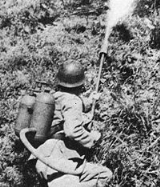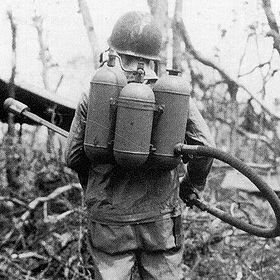
Type 93 and 100 flamethrowers
Encyclopedia

Flamethrower
A flamethrower is a mechanical device designed to project a long controllable stream of fire.Some flamethrowers project a stream of ignited flammable liquid; some project a long gas flame. Most military flamethrowers use liquids, but commercial flamethrowers tend to use high-pressure propane and...
s used by the Imperial Japanese Army
Imperial Japanese Army
-Foundation:During the Meiji Restoration, the military forces loyal to the Emperor were samurai drawn primarily from the loyalist feudal domains of Satsuma and Chōshū...
and Imperial Japanese Navy
Imperial Japanese Navy
The Imperial Japanese Navy was the navy of the Empire of Japan from 1869 until 1947, when it was dissolved following Japan's constitutional renunciation of the use of force as a means of settling international disputes...
's SNLF during the Second Sino-Japanese War
Second Sino-Japanese War
The Second Sino-Japanese War was a military conflict fought primarily between the Republic of China and the Empire of Japan. From 1937 to 1941, China fought Japan with some economic help from Germany , the Soviet Union and the United States...
and World War II.
History and development
Japanese military observersMilitary attaché
A military attaché is a military expert who is attached to a diplomatic mission . This post is normally filled by a high-ranking military officer who retains the commission while serving in an embassy...
stationed in Europe noted effectiveness of flamethrowers during the trench warfare
Trench warfare
Trench warfare is a form of occupied fighting lines, consisting largely of trenches, in which troops are largely immune to the enemy's small arms fire and are substantially sheltered from artillery...
conditions of World War I, particularly against battlefield fortifications, bunkers, pillboxes and similar protected emplacements, which had given the Japanese Army such grief during the Siege of Port Arthur
Siege of Port Arthur
The Siege of Port Arthur , 1 August 1904 – 2 January 1905, the deep-water port and Russian naval base at the tip of the Liaotung Peninsula in Manchuria, was the longest and most violent land battle of the Russo-Japanese War....
during the Russo-Japanese War
Russo-Japanese War
The Russo-Japanese War was "the first great war of the 20th century." It grew out of rival imperial ambitions of the Russian Empire and Japanese Empire over Manchuria and Korea...
of 1904-1905.
The Type 93 flamethrower, largely based on European designs, entered service in 1933. It was used in Manchukuo
Manchukuo
Manchukuo or Manshū-koku was a puppet state in Manchuria and eastern Inner Mongolia, governed under a form of constitutional monarchy. The region was the historical homeland of the Manchus, who founded the Qing Empire in China...
against the ill-prepared National Revolutionary Army
National Revolutionary Army
The National Revolutionary Army , pre-1928 sometimes shortened to 革命軍 or Revolutionary Army and between 1928-1947 as 國軍 or National Army was the Military Arm of the Kuomintang from 1925 until 1947, as well as the national army of the Republic of China during the KMT's period of party rule...
of the Republic of China
Republic of China
The Republic of China , commonly known as Taiwan , is a unitary sovereign state located in East Asia. Originally based in mainland China, the Republic of China currently governs the island of Taiwan , which forms over 99% of its current territory, as well as Penghu, Kinmen, Matsu and other minor...
and against local warlord
Warlord
A warlord is a person with power who has both military and civil control over a subnational area due to armed forces loyal to the warlord and not to a central authority. The term can also mean one who espouses the ideal that war is necessary, and has the means and authority to engage in war...
forces with considerable psychological effect. However, its ignition system based on a heated electrical wire had reliability issues under cold weather conditions which led to a redesign designated the Type 100 flamethrower in 1940. Both types remained in service during World War II.
Design
Both the Type 93 and Type 100 consisted of a fuel unit, fuel hose, and flame gun. A modification in the design of the flame gun is the only difference between the two types.The fuel unit consisted of three 15 inches (381 mm), 6 inches (152.4 mm) cylinders: two outer fuel cylinders and a central nitrogen
Nitrogen
Nitrogen is a chemical element that has the symbol N, atomic number of 7 and atomic mass 14.00674 u. Elemental nitrogen is a colorless, odorless, tasteless, and mostly inert diatomic gas at standard conditions, constituting 78.08% by volume of Earth's atmosphere...
pressure cylinder
Pressure vessel
A pressure vessel is a closed container designed to hold gases or liquids at a pressure substantially different from the ambient pressure.The pressure differential is dangerous and many fatal accidents have occurred in the history of their development and operation. Consequently, their design,...
. The total fuel capacity was 12.3 liters. Fuel was a mixture of gasoline
Gasoline
Gasoline , or petrol , is a toxic, translucent, petroleum-derived liquid that is primarily used as a fuel in internal combustion engines. It consists mostly of organic compounds obtained by the fractional distillation of petroleum, enhanced with a variety of additives. Some gasolines also contain...
and tar
Tar
Tar is modified pitch produced primarily from the wood and roots of pine by destructive distillation under pyrolysis. Production and trade in tar was a major contributor in the economies of Northern Europe and Colonial America. Its main use was in preserving wooden vessels against rot. The largest...
. Pressure was controlled by a manually-operated needle valve
Needle valve
A needle valve is a type of valve having a small port and a threaded, needle-shaped plunger. It allows precise regulation of flow, although it is generally only capable of relatively low flow rates.- Construction and operation :...
, one on the top of each of the two fuel cylinders. This tank assembly was fitted with straps to permit it to be carried on the operator's back like an infantry pack.
The 45 inches (1,143 mm) fuel hose was made of reinforced rubber tubing, with brass fittings on both ends. The flame gun, three to four feet long, was a 1 inches (25.4 mm) tube with a fuel ejection handle located near the hose connection, and a 1/4-inch nozzle with the firing mechanism attached to the other end.
Fuel (in the Type 100) was ignited by a blank cartridge fired from a revolver
Revolver
A revolver is a repeating firearm that has a cylinder containing multiple chambers and at least one barrel for firing. The first revolver ever made was built by Elisha Collier in 1818. The percussion cap revolver was invented by Samuel Colt in 1836. This weapon became known as the Colt Paterson...
mechanism in the flame gun, which held ten rounds. The fuel ejection handle fired a cartridge when it opened the fuel ejection valve. When the handle was returned to its closed position parallel to the tube, the flow of fuel stopped, and the magazine revolved to place a new cartridge in the firing position. The duration of a continuous discharge was 10 to 12 seconds with a maximum range of 22 to 27 meters.
| Type 93 | Type 100 | |
| Maximum range | 25 to 30 yards (22 to 27 meters) | |
| Maximum discharge time | 10 to 12 seconds | |
| Fuel capacity | 3.25 U.S. gallons (12.3 liters) | |
| Weight | 26 kg (57 lb) (approx) | |
| Flame gun length | 47⅛ in (1,197 mm) | 35½ in (902 mm) |
| Weight | 10 lb (4.5 kg) | 8.5 lb (3.9 kg) |
| Nozzle outlet tip | Fixed | Removable |
| Diameter of cartridge | 0.44 in (11.1 mm) | 0.484 in (12.3 mm) |
Combat record
Flamethrowers were assigned to engineering regimentsMilitary engineer
In military science, engineering refers to the practice of designing, building, maintaining and dismantling military works, including offensive, defensive and logistical structures, to shape the physical operating environment in war...
within each Japanese infantry division. A typical engineering regiment would be equipped with between six and twenty flamethrowers, which were operated by a designated flamethrower company. The Type 100 Flamethrower was primarily used in the early stages of the Pacific War
Pacific War
The Pacific War, also sometimes called the Asia-Pacific War refers broadly to the parts of World War II that took place in the Pacific Ocean, its islands, and in East Asia, then called the Far East...
, mostly in the Dutch East Indies
Dutch East Indies campaign
The Dutch East Indies campaign of 1941–1942 was the conquest of the Dutch East Indies by forces from the Empire of Japan in the early days of the Pacific Campaign of World War II. Forces from the Allies attempted unsuccessfully to defend the islands. Indonesia was targeted by the Japanese for its...
, Burma
Japanese capture of Burma
The Burma Campaign in the South-East Asian Theatre of World War II took place over four years from 1942 to 1945. During the first year of the campaign, the Japanese Army drove British Commonwealth and Chinese forces out of Burma, and occupied the country, forming a Burmese administration with...
and the Philippines. Type 100-equipped Japanese paratrooper
Paratrooper
Paratroopers are soldiers trained in parachuting and generally operate as part of an airborne force.Paratroopers are used for tactical advantage as they can be inserted into the battlefield from the air, thereby allowing them to be positioned in areas not accessible by land...
s participated in the Battle of Palembang in 1942. There was little need for flamethrowers later in the war since Japan was on the defensive and had few opportunities to attack enemy fortifications. In later stages of the war, the Japanese army attempted to use the Type 100 flamethrower as an anti-tank weapon, largely due to lack of any effective anti-tank guns, but with limited success.

